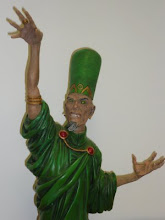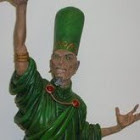A very enjoyable and engaging western with a wonderful title that shows from the outset that the creators are going to embrace the genre conventions and avoid cliches. In a super opening sequence Ric McClune gets a letter and a gunfight and heads off to find the man who sent the letter. Ray, the letter writer wants Ric to find his wife and daughter who have been abducted by a religious group. Ric takes the work and sets off and finds a lot more than he expected.
Hayden Suurell includes all the elements a western should have, a saloon scene, a crusty old man, a pursuit of a bounty and a great gunfight. All are delivered with a fresh eye that is simply a delight to read. The most important signal that the reader is in the hands of confident creators who know what they are doing is that Ric is not wearing a Stetson hat, he wears a bowler. It is a small and important detail; it goes a long way to establish Ric as an individual the writing does the rest. Ric is a great character, tough and ready with his gun, he is a bounty hunter, so he needs to be. There is more to Ric and that is nicely revealed as the story unfolds. The rest of the cast, including some very important walk on parts are all given the spark of life, they are never just targets for Ric to shoot.
Ben Sullivan’s art is a pleasure to read and linger over. The page compositions are smart and varied, they move the story at the right pace and frame the action with thoughtful care. The cast are expressive, individual and absolutely at ease in their context.
The colours of a western are critical, if the comic is not black and white it has to come to terms with the colours from the cinema and deal with them in some way. Jeff Edis’ colours are spot on; they are western colours and they give the story and art the depth they deserve. The story is nicely dark, and the clear colours allow it to breathe without pushing the reader.
Darren Close’s lettering is subtle and natural to read, it allows the story to flow, is easily readable and never distracts the reader.
I am a long tern fan of westerns and finding a really good one is a cause for celebration. Second Fastest Gun in The West Ric McClune is definitely a cause for celebration.








